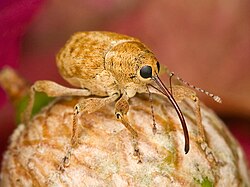| Curculio | |
|---|---|
 | |
| A filbert weevil ( Curculio occidentis ) on an acorn cap | |
| Scientific classification | |
| Kingdom: | Animalia |
| Phylum: | Arthropoda |
| Class: | Insecta |
| Order: | Coleoptera |
| Suborder: | Polyphaga |
| Infraorder: | Cucujiformia |
| Family: | Curculionidae |
| Subfamily: | Curculioninae |
| Genus: | Curculio Linnaeus, 1758 |
| Species | |
About 30; see text | |


Curculio is a genus of weevils belonging to the family Curculionidae and subfamily Curculioninae. [1] [2] Members of the genus are commonly referred to as acorn weevils or nut weevils, as they infest the seeds of trees such as oaks and hickories. The adult female weevil bores a tiny hole in the immature nut to lay her eggs, which then hatch into legless grubs. In autumn, the grubs bore holes through the shells from the inside to emerge into the soil, where they may live for a year or two before maturing into adults. [3]